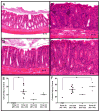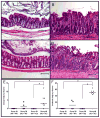Critical role for P-glycoprotein expression in hematopoietic cells in the FVB.Mdr1a(-/-) model of colitis
- PMID: 21681110
- PMCID: PMC3658612
- DOI: 10.1097/MPG.0b013e31822860f1
Critical role for P-glycoprotein expression in hematopoietic cells in the FVB.Mdr1a(-/-) model of colitis
Abstract
Objective: P-glycoprotein (P-gp), the functional product of the multidrug resistance gene (MDR), is a transmembrane protein that extrudes substrates from the intracellular environment. P-gp is expressed on the apical surface of epithelial cells and on cells from the hematopoietic lineage. Human MDR polymorphisms have been associated with the increased risk of inflammatory bowel disease, and FVB/N animals deficient in mdr1a expression develop spontaneous colitis. Previous studies using adult bone marrow chimeras indicated that colitis development in this animal model was contingent on P-gp deficiency in radiation-resistant epithelial cells; however, the use of adult animals may mask the role of hematopoietic immune cells in colitis initiation, due to preexisting epithelial abnormalities.
Subjects and methods: To assess the importance of P-gp expression in intestinal epithelial and hematopoietic-derived cells on colitis induction in FVB.mdr1a(-/-) animals, we developed a neonatal model of bone marrow reconstitution. FVB/N and FVB.mdr1a(-/-) adult and neonatal animals were lethally irradiated and reconstituted with bone marrow from FVB/N or FVB.mdr1a(-/-) donors. Animals were observed for 20 weeks.
Results: Adult FVB/N animals deficient in P-gp expression in hematopoietically derived immune cells developed colitis similar to adult animals deficient in P-gp expression in radiation-resistant epithelial/stromal cells. Neonatal animals deficient in P-gp expression in hematopoietically derived immune cells developed a more histologically significant colitis than those deficient in P-gp expression in epithelial tissue.
Conclusions: The use of a neonatal model of bone marrow reconstitution has revealed a critical role for P-gp expression in hematopoietically derived immune cells in colitis development in the FVB.mdr1a(-/-) model.
Figures






Similar articles
-
Altered generation of induced regulatory T cells in the FVB.mdr1a-/- mouse model of colitis.Mucosal Immunol. 2013 Mar;6(2):309-23. doi: 10.1038/mi.2012.73. Epub 2012 Aug 8. Mucosal Immunol. 2013. PMID: 22874899 Free PMC article.
-
Upregulation of P-glycoprotein by probiotics in intestinal epithelial cells and in the dextran sulfate sodium model of colitis in mice.Am J Physiol Gastrointest Liver Physiol. 2011 Jun;300(6):G1115-23. doi: 10.1152/ajpgi.00027.2011. Epub 2011 Feb 24. Am J Physiol Gastrointest Liver Physiol. 2011. PMID: 21350189 Free PMC article.
-
Resolution of P-glycoprotein and non-P-glycoprotein effects on drug permeability using intestinal tissues from mdr1a (-/-) mice.Br J Pharmacol. 2002 Apr;135(8):2038-46. doi: 10.1038/sj.bjp.0704668. Br J Pharmacol. 2002. PMID: 11959808 Free PMC article.
-
Multidrug resistance 1 gene in inflammatory bowel disease: a meta-analysis.World J Gastroenterol. 2006 Jun 21;12(23):3636-44. doi: 10.3748/wjg.v12.i23.3636. World J Gastroenterol. 2006. PMID: 16773678 Free PMC article. Review.
-
The mdr1a-/- mouse model of spontaneous colitis: a relevant and appropriate animal model to study inflammatory bowel disease.Immunol Res. 2005;31(2):151-9. doi: 10.1385/IR:31:2:151. Immunol Res. 2005. PMID: 15778512 Review.
Cited by
-
Altered generation of induced regulatory T cells in the FVB.mdr1a-/- mouse model of colitis.Mucosal Immunol. 2013 Mar;6(2):309-23. doi: 10.1038/mi.2012.73. Epub 2012 Aug 8. Mucosal Immunol. 2013. PMID: 22874899 Free PMC article.
-
Animal models of ulcerative colitis and their application in drug research.Drug Des Devel Ther. 2013 Nov 12;7:1341-57. doi: 10.2147/DDDT.S40107. eCollection 2013. Drug Des Devel Ther. 2013. PMID: 24250223 Free PMC article. Review.
-
High ABCC2 and low ABCG2 gene expression are early events in the colorectal adenoma-carcinoma sequence.PLoS One. 2015 Mar 20;10(3):e0119255. doi: 10.1371/journal.pone.0119255. eCollection 2015. PLoS One. 2015. PMID: 25793771 Free PMC article.
-
Maintenance of host leukocytes in peripheral immune compartments following lethal irradiation and bone marrow reconstitution: implications for graft versus host disease.Transpl Immunol. 2013 Mar;28(2-3):112-9. doi: 10.1016/j.trim.2013.01.001. Epub 2013 Jan 17. Transpl Immunol. 2013. PMID: 23334064 Free PMC article.
-
P-glycoprotein multidrug transporter in inflammatory bowel diseases: More questions than answers.World J Gastroenterol. 2017 Mar 7;23(9):1513-1520. doi: 10.3748/wjg.v23.i9.1513. World J Gastroenterol. 2017. PMID: 28321153 Free PMC article.
References
-
- Fromm MF. P-glycoprotein: a defense mechanism limiting oral bioavailability and CNS accumulation of drugs. Int J Clin Pharmacol Ther. 2000;38(2):69–74. - PubMed
-
- Mizutani T, Masuda M, Nakai E, Furumiya K, Togawa H, Nakamura Y, et al. Genuine functions of P-glycoprotein (ABCB1) Curr Drug Metab. 2008;9(2):167–74. - PubMed
-
- Klimecki WT, Futscher BW, Grogan TM, Dalton WS. P-glycoprotein expression and function in circulating blood cells from normal volunteers. Blood. 1994;83(9):2451–8. - PubMed
Publication types
MeSH terms
Substances
Grants and funding
LinkOut - more resources
Full Text Sources
Medical
Miscellaneous

